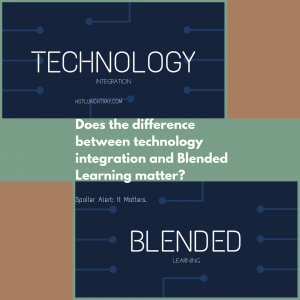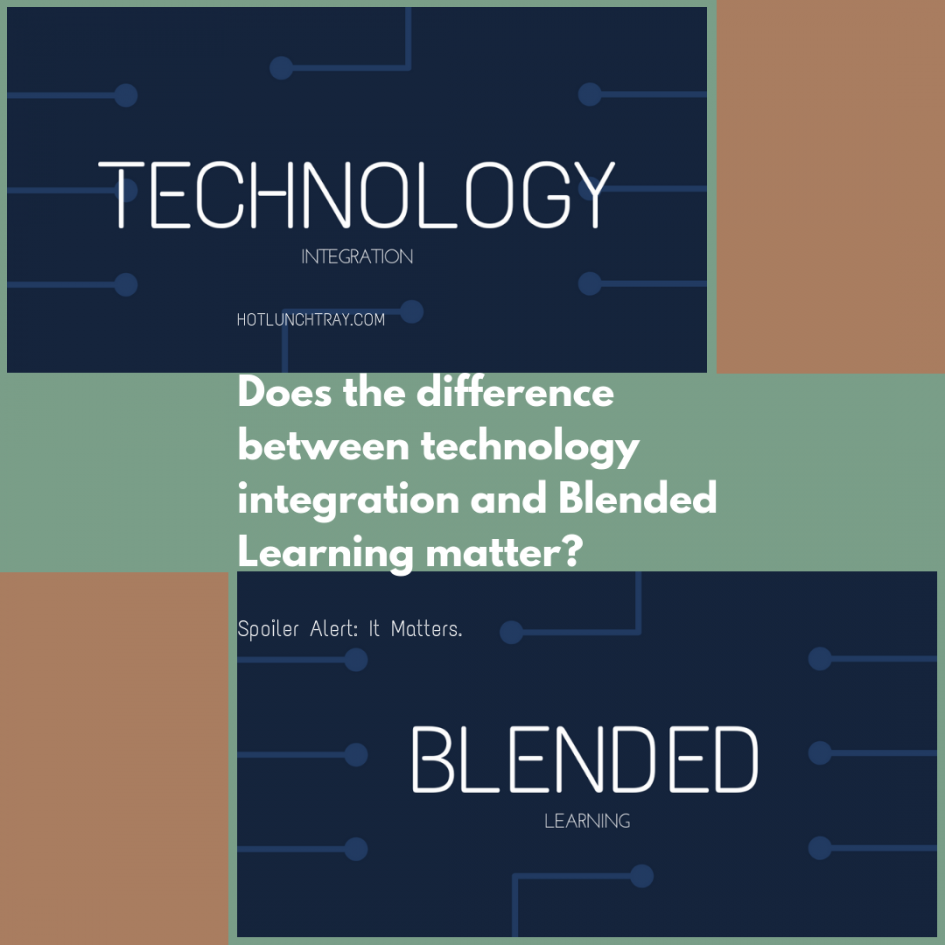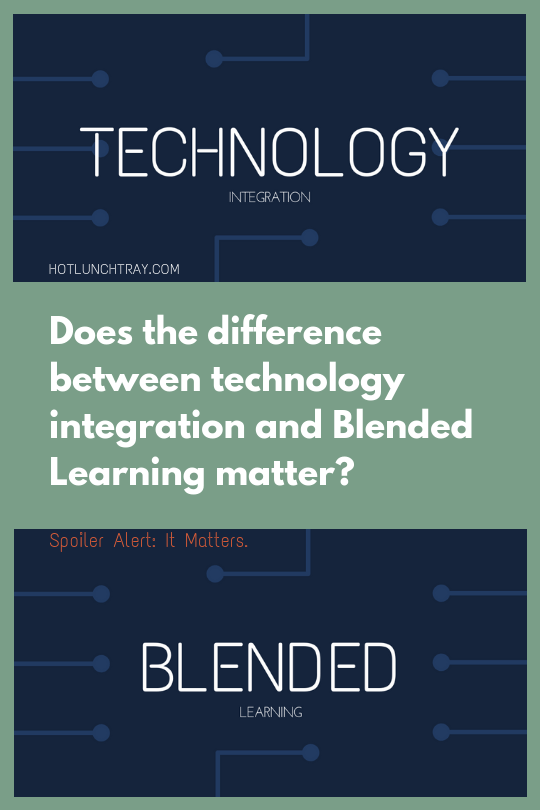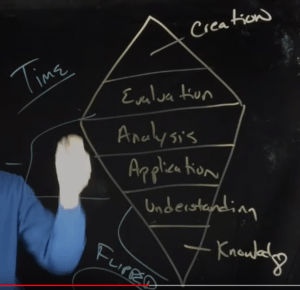If educators have been so confused, for so long, about the difference between technology integration and Blended Learning, does it matter?
Maybe these terms mean the same thing or so close that the difference isn’t important?
Spoiler Alert: It Matters
Having a strong definition of Blended Learning and how it differs from technology integration is crucial.
Here is Why…
Return on Investment
Technology Tools
Any educators spending resources on educational technology care about return on investment. Whether you are a classroom teacher spending time in setting something up or the Chief Technical Officer spending money, you want to realize a return on your investment. Some technology investments pay off in student gains, and some in teacher gains. It then makes sense to look at which type of technology we invest in and what we agree is the purpose of that technology in advance.
Eric Sheninger finesses the phrase to “Return on Instruction” by which he asks how student learning outcomes improve based on the integration of technology in a classroom.
Every educator needs to expect each investment in the classroom to be so questioned.
There are variables to call out when we question the return on educational technology: efficiency versus transformation, blended learning versus technology integration, the best way to use the teaching and learning time we enjoy with students.
Which Type?
All educators are happy to invest in increased teacher efficiency. Teachers deserve support to work smarter and not harder. If technology does that, it is fantastic. However the return on investment realized by your largest employee group, teachers, and not directly by students in some cases. Consider this presentation on Type 1, Type 2 tools. Teacher Efficiency is a Type 1 is sometimes a part of technology integration in our schools. That investment is in employees and not students IF the outcome of the investment if for (A) increased teacher efficiency or (B) making the job of the teacher easier to do. There is nothing wrong with this type of technology. But to be clear, this technology investment does not increase student learning directly.
Type 2 technology use either (A) transforms the way teachers teach students or (B) changes the way students learn.
Sometimes, the difference is easily categorized by if “Training” or “Professional Development/Learning” is the delivery method for each type of technology. This is not always an accurate representation, but a good guideline. Sometimes the tool application is not well examined and the wrong training/professional learning is applied. This mis-messaging results in confusion and possible failure of associated initiatives.
Teacher Efficiency
Making the job of teaching easier is a great cause. However, to invest in only making teacher’s work easier is not enough. A school or district wants to invest in tools which making learning easier, quicker, more evident.
The positive change in teacher practice can be independent of an increased student achievement; however, student achievement is, in fact, dependent on a high level of teacher practice. (Maddox and Johnson, 2006)
Improved Teaching & Learning
The Case for Blended Learning

Most teachers are not online teachers, most teachers are face-to-face teachers. Historically we have a good grasp of the best practices for face-to-face teaching and learning. Face-to-face strategies do not directly translate to an online classroom. Because technologies offer access to the learning and access is no longer controlled by physically being in a room with the teacher, the manner in which students interact with the learning is different and not always teacher-centered.
There is a need to change our expectations for teaching and learning; as we selectively increase online facets to our teaching and learning. In Blended Learning, access to online content is altered in four key ways: time, place, pace, and path. And because those are now variables for a new manner of teaching and learning both the content we teach and the way in which we teach it needs to respond to this new reality. This is why a definition like The Christensen Institute’s is important.
More than Efficiency
New ways to learn are not limited to only increased efficiency. Consider the SAMR model as another way to describe the manner in which technology is used to learn. The two lowest levels of SAMR to reach, Substitution and Augmentation, do not transform learning they increase the efficiency of the learning we have always done, not unlike Type I technology for teachers.
Educational leaders would do better to name the SAMR level of educational technology and drop the word “integration” from Technology Integration. Pure substitution does not result in increased student achievement because the task is not really changed. While augmentation provides functional improvements, neither substitution nor augmentation is worth the cost of the technology or the opportunity cost for the students. (Read: Different, but Not Better) Learning activities that fall within the substitution and augmentation classifications are said to enhance learning while learning activities that fall within the modification and redefinition classifications are said to transform learning (Puentedura, 2013).
The performance lessons to the higher Modification and Redefinition levels is not a daily event. And the understanding that not every lesson moves past “integration” to a level of Blended Learning is important to avoid frustration. (Read: Three Things about SAMR). It is at these higher levels of the SAMR framework that the full potential of learning via mobile learning is realized (Hockley, 2013).
The very act of transforming lessons after the fact is a hallmark of technology integration. Educators do offer that the SAMR model puts too much emphasis on higher-level integration (Savignano, 2017). SAMR alone then is not broad enough to be the definition of Blended Learning; instead, limiting teachers to the two lowest levels most often obscures the nuance of what teachers offer their students.
Increased Effect Size
Planning lessons with elements of flexing: Time, place, path, and place results in Blended Learning with a higher impact on learners. The very fact that teachers can flex a classroom into meaningful learning activities while working more intensely with smaller groups is why Blended Learning is an important strategy to incorporate. Those stand-alone activities still represent a marginal effect size and then when students rotate through the station with their teacher they can enjoy the highest benefit of a Blended Learning environment –
…teachers are clearly the biggest impact lever in blended learning, it’s easy to understand why technology often steals the limelight. For one, it’s much harder to recruit, develop, and support effective teachers than it is to buy new devices or software licenses; and when you walk into a classroom, new shiny hardware and flashy software are more eye-catching than the skills and expertise living inside a teacher’s mind. Thus, education leaders are easily drawn to the electronic aspects of blended learning at the neglect of the real engines of success. Additionally, blended learning and quality teaching can often seem like distinct and separate initiatives. On the landscape of education reforms, blended learning and teacher quality each has its own set of policy proponents, technical support organizations, publications, and conferences.
Yet despite the false dichotomy often drawn between improving schools through excellent teaching and improving schools through technology, teacher quality, and online learning are not isolated and independent variables. Rather, they are complementary components of an effective blended learning system (Arnett).
The largest effect sizes happen between teacher and learner. Strategically grouping and regrouping for more rigorous experiences is a real possibility in Blended Learning, but not necessarily in technology integration alone.
Stop trying to make technology more impactful than you working directly with students; instead use technology wisely to gain more direct access to the students who need your guidance.
Creating a teacher station within a rotation or flipping the classroom needs to have thoughtful online activities complementing all the ways students learn. The related opportunities for learning online must directly connect to face-to-face work, not be only supplemental or enrichment (Johnson, 2014).
We must specify what we want for our classrooms: We want to invest in practices which result in more benefit than cost. And acknowledge that while we have the capability to present learning opportunities online, not all online opportunities – and the resulting opportunities left for face-to-face instruction – are equal.
Meta-Strategy
Teaching Reimagined
Blended learning is a meta-strategy. A meta-strategy makes other strategies possible. Blended Learning organizes learning opportunities in your both your online and face-to-face classroom.
Because Blended Learning can personalize how groups of students, and individual students, can experience class content it enables other strategies by redistribution of time. (Bergmann, 2018)
I finally fully understood this idea by completing Jonathan Bergmann’s course Flipped Learning certification course. It was a concept which a long-term face-to-face classroom teacher may grapple with more than once to fully understand: Bergmann explains the way time is shifted by re-ordering tasks between the individual and group spaces.
Blended Learning is the teaching strategy which intelligently redistributes time to allow for other teaching strategies which align with student passion and authentic work. Blended Learning is the one teaching strategy in the digital age which enables all other effective teaching strategies.
Blended Learning is also the learning strategy which makes possible student choice/voice in their learning.
Yes, and…
The right Tools and Strategies means …
Because you have redistribution of time in a Blended Learning you have time to try other learning configurations in class which can activate powerful learning experiences: agency, authentic audience, connectivity, and creativity. (Tucker, Blended Learning in Action, 2017)
What ends up being unique is how each teacher blends technology into their instructional design, not adds technology on top of the instructional already designed.
That is the big difference between technology integration and Blended Learning. Technology integration tends to happen to students at the per lesson level without offering more than a new way to complete the lesson. Blended Learning is a meta-strategy for instruction which builds in for sustained time shifting for individuals throughout the course duration.
That is why starting from a strong definition of Blended Learning and how it differs from technology integration is crucial.
The definition rules out adding technology on after the instructional design and then being disappointed in
results/getting inconsistent results/thinking there is no gain in Blended Learning.
Having a strong definition of Blended Learning and how it differs from technology integration is crucial.
It makes teaching and earning more powerful and effective to converse about the same topic instead of guessing what another educator means by the term they are using.
And yes, there is a difference.
Arnett, Thomas, 2018: “The Secret Element in Blended Learning.” The Christensen Institute, May 9, 2018. https://www.christenseninstitute.org/blog/the-secret-element-in-blended-learning/?_sft_topics=personalized-blended-learning
Bergmann, Johnathan, 2018. “Sharing the Best Global Research, Practices and Technology for Successful Flipped Learning.” FLGlobal, learn.flglobal.org/.
Hockly, N., 2013: Technology for the language teacher: Mobile learning. ELT Journal, 67(1), 80–84.
doi:10.1093/elt/ccs064
Horn, Michael B, and Heather Staker. “Blended Learning.” Christensen Institute, www.christenseninstitute.org/blended-learning/.
Johnson, Jen. “Blended Learning and Technology Integration” YouTube. Jan 20, 2014, https://www.youtube.com/watch?v=KD8AUfGsCKg&feature=youtu.be.
Maddox & Johnson, 2006: Type II Uses of Technology in Education. Maddux & Johnson Editors.
Puentedura, R. R. (2006, November 28). Transformation, technology, and education in the state of Maine
[Web log post]. Retrieved from https://www.hippasus.com/rrpweblog/archives/2006_11.html.
Puentedura, R. R. (2013, May 29). SAMR: Moving from enhancement to transformation [Web log post].
Retrieved from https://www.hippasus.com/rrpweblog/archives/000095.html
Savignano, Mark Angelo, “Educators’ Perceptions of the Substitution, Augmentation, Modification, Redefinition Model for
Technology Integration” (2017). Dissertations. https://digscholarship.unco.edu/dissertations/451.








2019-01-31 at 10:17 am
Needless to say, teaching is a major factor affecting the quality of education. Many private schools, though not all, have dedicated, passionate, and well-trained teachers.
2019-06-24 at 9:45 am
Very useful content and information. Teacher efficiency and technology goes hand in hand. This is a very important piece of information for educators as well as parents.
James Cothern recently posted…What Is Electronic Contract Manufacturer?
2019-07-17 at 9:48 am
I wanted to send you the very small word to finally thank you so much once again about the magnificent things you’ve documented on this website. It has been pretty generous of you to deliver openly what most people would have distributed as an e book to make some dough for their own end, most importantly given that you could possibly have done it if you ever wanted. The advice in addition served like a good way to comprehend other individuals have the same dream similar to mine to find out lots more on the topic of this matter. I am certain there are millions of more pleasurable periods in the future for individuals who read your site.
2019-09-10 at 6:47 am
I love it when bloggers use plain language in their posts so everyone can understand them too and you have done that, it was very useful information, thanks for sharing
2019-12-20 at 6:37 am
Substance and exceptionally valuable data. The effectiveness and innovation of the educator depend on the hip. This is an important data element for trainers as parents. In addition, the guide served as a decent way to understand that others have a dream similar to mine to discover more parts on the subject.
2020-10-07 at 4:37 pm
This is a must-read. I should develop a positive attitude towards blended learning now that we should have a strong grip on it because of the global pandemic. Choosing the most appropriate tools will improve online teaching and learning.
Karen Pao recently posted…Which Between a Tablet and a Laptop Should Teachers Use in the Classroom?
2021-09-27 at 3:37 am
Being a teacher I totally agree with the overall pointers mentioned in the blogpost.
shelar recently posted…CAT 2020: Everything You Need To Know